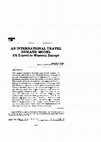Papers by Kenneth J White
Econometrica, May 1, 1979
... BY SALLY M. RICHARDSON AND KENNETH J. WHITE1 ... See, for example, Koerts and Abrahamse [3], ... more ... BY SALLY M. RICHARDSON AND KENNETH J. WHITE1 ... See, for example, Koerts and Abrahamse [3], L'Esperance and Taylor [4], Tillman [6], and Ward [7]. In the case of missing observations we can compute the power of d' and d* for a given X* matrix by first selecting a ...
Econometrica, 1978
... OBSERVATIONS1 By NE SAVIN AND KENNETH J. WHITE ... function. 4 All calculations for this Sect... more ... OBSERVATIONS1 By NE SAVIN AND KENNETH J. WHITE ... function. 4 All calculations for this Section were performed using the computer program SHAZAM written by White [23] which incorporates the procedures of Sections 3 and 4 above. ...
... Post a Comment. CONTRIBUTORS: Author: White, Kenneth J. Author: Bui, Linda TM. Author: Berndt... more ... Post a Comment. CONTRIBUTORS: Author: White, Kenneth J. Author: Bui, Linda TM. Author: Berndt, Ernst R. ... VOLUME/EDITION: PAGES (INTRO/BODY): SUBJECT(S): Econometrics; Computer programs; SHAZAM (Computer file). DISCIPLINE: No discipline assigned. ...
Econometrica, 1979
... BY SALLY M. RICHARDSON AND KENNETH J. WHITE1 ... See, for example, Koerts and Abrahamse [3], ... more ... BY SALLY M. RICHARDSON AND KENNETH J. WHITE1 ... See, for example, Koerts and Abrahamse [3], L'Esperance and Taylor [4], Tillman [6], and Ward [7]. In the case of missing observations we can compute the power of d' and d* for a given X* matrix by first selecting a ...
Econometrica, 1978
... OBSERVATIONS1 By NE SAVIN AND KENNETH J. WHITE ... function. 4 All calculations for this Sect... more ... OBSERVATIONS1 By NE SAVIN AND KENNETH J. WHITE ... function. 4 All calculations for this Section were performed using the computer program SHAZAM written by White [23] which incorporates the procedures of Sections 3 and 4 above. ...

Annals of Tourism Research, 1985
This paper examines international travel demand between the United States and Western Europe. A c... more This paper examines international travel demand between the United States and Western Europe. A complete system of demand equations is estimated to obtain expenditure and price elasticities of the demand for travel. The results allow the classification of regions of Western Europe as substitutes or complements according to the preferences of travelers. It is found that Americans view Norway, Sweden, Denmark, Spain, and Portugal as "luxury destinations" that might expect to receive an increasing share of the traveler's budget. The price elasticities are relatively low for France, Belgium, the Netherlands, and Luxembourg. France and the U.K. exhibited high price substitution effects as did France and Germany. Travel to most other countries might be classified as complementary with respect to travel to France and substitutes with respect to the U.K. Keywords: travel demand, econometric model, Western Europe. Kenneth White is Associate Professor of Economics at the University of British Columbia (Vancouver, Canada V6T 1Y2}. His interests include econometric modeling and measurement problems.
Communication Research, Oct 1, 1977
An understanding of the determinants of viewer choice is fundamental to an analysis of the struct... more An understanding of the determinants of viewer choice is fundamental to an analysis of the structure and profitability of the television broadcasting industry. This study approaches the question by broadly analyzing the distribution of audiences among programs and stations. Examination of national television ratings reveals that the share of the market captured by a given program varies widely across the

THE EXISTENCE OF the Keynesian liquidity trap at relatively low interest rates has been a frequen... more THE EXISTENCE OF the Keynesian liquidity trap at relatively low interest rates has been a frequent theme in studies of the demand for money. When examining past empirical work in this area, one finds the use of rather crude statistical tests for the presence of the liquidity trap and no consensus about the appropriate functional form of the demand equation. Bronfenbrenner and Mayer [2] followed the idle balance approach devised by Tobin [12] in 1947; however, the results obtained by this method were inconclusive. Brunner and Meltzer [3] concentrated on the necessary and sufficient conditions for the existence of the liquidity trap using the interest elasticity of the demand for money function. Unfortunately, they failed to develop the methodology needed for the estimation of the trap. A few recent studies have introduced the level of the liquidity trap explicitly so that the demand for money is a function of the difference between the observed interest rate and the minimum (liquidity trap) interest rate. This approach, applied by Klein and Goldberger [7] in their econometric model, has been extended by Pifer [11] and Konstas and Khouj [8]. One characteristic common to these studied is that the liquidity trap is assumed to be "asymptotic ;" the interest rate never actually reaches the "floor." In contrast, some define the liquidity trap as being "absolute" so that the demand curve becomes perfectly horizontal when the interest rate has reached its critical level. The controversy over the existence of the liquidity trap is partially due to the failure to distinguish between these two definitions. This paper is concerned only with the asymptotic liquidity trap and modifies the approach used in past studies, notably that of Pifer, to allow a less restrictive functional form.
Pacific Focus, Feb 13, 2008
National Tax Journal, Mar 1, 1973
TN a recent issue of this journal Joyce M. Nussbaum1 explored several aspects of the federal inco... more TN a recent issue of this journal Joyce M. Nussbaum1 explored several aspects of the federal income tax structure resulting in a "tax cost of marriage" for those families where both spouses work.2 This "marriage penalty" is defined to be the increment in tax liability resulting solely from the act of marriage. An unmarried couple living together will find that their total tax bill will increase by the amount of the penalty if they were to wed. This tax differential, which may be negative, results from the income splitting provisions of the tax laws, the relatively favorable tax rates for single individuals, and the specification of the standard deduction. Professor Nuss-
... Post a Comment. CONTRIBUTORS: Author: White, Kenneth J. Author: Theobald, Steven A. ... PAGES... more ... Post a Comment. CONTRIBUTORS: Author: White, Kenneth J. Author: Theobald, Steven A. ... PAGES (INTRO/BODY): 274 p. SUBJECT(S): Econometric models; Computer simulation; Handbooks, manuals, etc.; SHAZAM (Computer file). DISCIPLINE: No discipline assigned. ...
McGraw-Hill eBooks, 1991
... Post a Comment. CONTRIBUTORS: Author: White, Kenneth J. Author: Pindyck, Robert S. PUBLISHER:... more ... Post a Comment. CONTRIBUTORS: Author: White, Kenneth J. Author: Pindyck, Robert S. PUBLISHER: ... PAGES (INTRO/BODY): 226 p. SUBJECT(S): Economic forecasting; Econometric models; Computer programs; SHAZAM (Computer file). DISCIPLINE: No discipline assigned. ...
Social Science Research, Jun 1, 1976
In order to maximize the information disseminating function of campaigning, candidates for politi... more In order to maximize the information disseminating function of campaigning, candidates for political office must make numerous decisions regarding the allocation of resources for various campaign activities. One of the most important financial decisions a candidate must make occurs in ...
RePEc: Research Papers in Economics, 1987
The American Statistician, Feb 1, 1987
Economics Letters, 1986
While the Wald test can be used to test a non-linear hypothesis m a linear or non-linear regressi... more While the Wald test can be used to test a non-linear hypothesis m a linear or non-linear regression model it is known that a particular hypothesis can be written in many ways when non-linear forms are permitted. This paper illustrates that it is possible to obtain virtually any value of the Wald statistic at different significance levels. It is also shown that in small samples the use of the x2 or F approximation for the distribution of the Wald statistic can be misleading for some forms of the non-linear Wald test.
The Economic Journal, Dec 1, 1989









Uploads
Papers by Kenneth J White